Deodorization in Commercial Buildings
11/1/2019 (Permalink)
Effective odor removal in commercial buildings requires the four foundational principles of deodorization.
Principle 1: Identify and Remove the Primary Source
This is typically accomplished using the senses (site and smell) and by initial removal of the source by dry vacuum or sponge. Contractors should always contact the EPA, state or local environmental agencies for current disposal instructions of any chemicals left behind.
Principle 2: Clean the Contaminated Areas (Surfaces)
Cleaning is critical, and means physically cleaning residue by washing all surfaces starting at the source area and working outward. Washing of walls is recommended, whether there is visible residue or not.
Principle 3: Recreate the Conditions of Penetration
Recreation is typically accomplished with the appropriate application to reach penetration levels. Chlorine dioxide (“ClO2”) is a mature chemistry, that is an emerging odor control alternative for disaster restoration pros thanks to recent technological innovations. Although discovered in 1814, it wasn’t until the 1960’s that ClO2 emerged as the ‘go to’ chemistry for municipal water treatment to mitigate taste and odor issues while leaving no harmful by-products. Today, ClO2 is approved for many residential and commercial uses including deodorization, hospital-type disinfection, and mold control to name a few. SERVPRO offers SERVPROXIDE which helps elimination odors and kills 99.999% sanitization of food contact surfaces.
ClO2 in liquid form can be wiped, mopped or sprayed on to most surfaces, including colorfast soft surfaces. Additionally, ClO2 can be used as a vapor to deodorize difficult-to-access areas. Over the last four years, ClO2 has proven itself as a fast, effective, and scalable deodorizing and disinfection solution that is safe on most building materials and leaves no harmful chemical residue.
Principal 4: Sealing
Effective deodorization requires a combination of these principles; using only one technique, for example sealing, leads to incomplete and unsuccessful results. While sealing is not always required, it can be a solid last step.
SERVPRO of The Andovers is happy to provide you with a free estimate for all your commercial needs! 978.475.1199





 24/7 Emergency Service
24/7 Emergency Service
